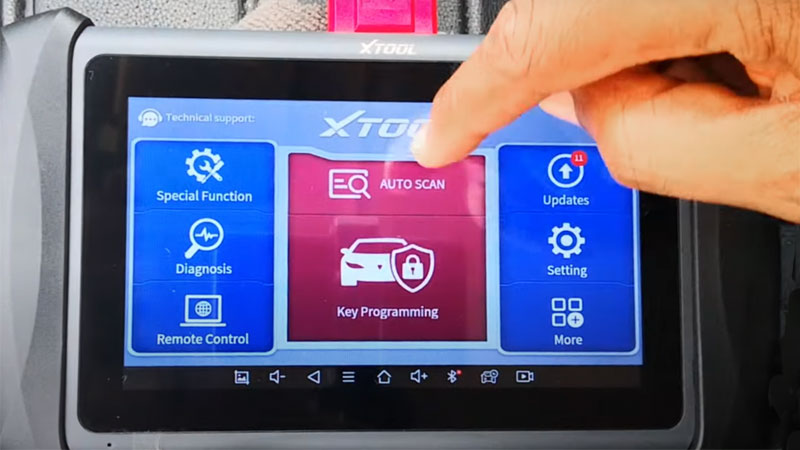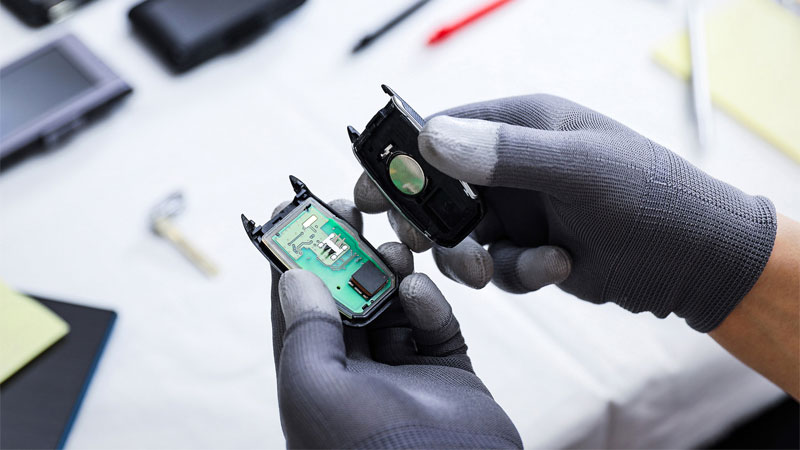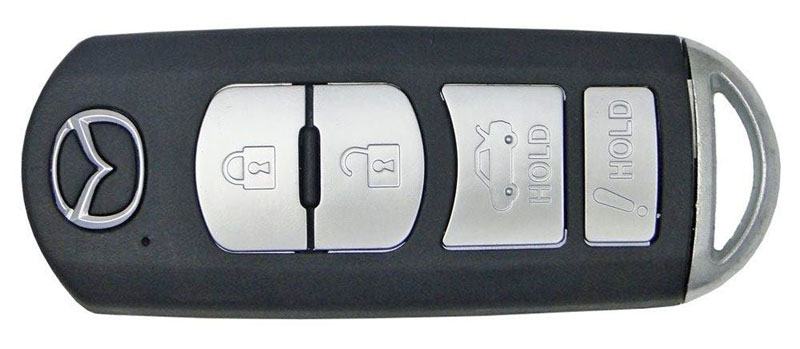A dead key fob is irritating, but a replaced battery should get it working again, right? Not always. Even new batteries can fail to revive unresponsive key fobs. But don’t worry – the problem is likely an easy fix once the cause is identified.
This article will explore the common reasons behind key fobs that continue to fail post-battery replacement. Discovering what’s impairing your key fob functionality is the first step to restoring the convenience of keyless entry.
We’ll look at the typical culprits that keep key fobs from operating normally. Armed with an understanding of what’s gone wrong, you’ll know how to get your key fob up and running again.
Understanding Key Fob Basics
Key fobs are a common and convenient device used in modern cars to remotely control various functions such as locking and unlocking doors, opening trunks, and sometimes even starting the engine or rolling down the windows. These little gadgets usually come in the form of a small remote with buttons, encased in a plastic shell, which is attached to your car key.
The basic principle behind a key fob is that it uses a specific radio frequency to communicate with your car’s onboard computer. When you press a button on your key fob, a signal is sent to your car, and the corresponding action is carried out. For example, if you press the lock button, the car’s doors will lock.
However, just like any other electronic device, key fobs can sometimes stop working. Often the first step is to replace the battery. But what do you do if the key fob STILL doesn’t work once you’ve done that?
Read Also – Key Stuck In Your Ignition? (Here’s Why)
Reasons the Key Fob Is Not Working
1. Key Fob Damage
Take some time to closely inspect the physical condition of your key fob and look for any signs of internal damage that could be impairing its performance. Cracks or holes in the casing can allow dirt, dust and moisture inside which can short out the circuit board and electrical components.
Also check for any loose, rattling parts or buttons that don’t press down firmly anymore. This may indicate broken springs or internal parts that need to be repaired or replaced. Consider pressing each button multiple times to check for inconsistencies. If one or more buttons trigger the lock/unlock less reliably than others, that points to a deeper mechanical problem.
If you notice any of these physical defects, worn parts or intermittent issues, it may be worth taking your key fob to an auto repair shop to have a technician inspect it more thoroughly. They may be able to repair it or determine if the internal damage is severe enough that replacing the key fob completely would be the better, longer-lasting solution.
2. Issues Related to the Lock System
Before blaming your key fob, consider that the real issue may lie in your car’s lock system itself. Test whether your physical key opens the doors – if it doesn’t, that points to a problem with the locks, not the fob. Inspect the door locks closely for debris, sticking, or corrosion that could cause malfunction.
You can also try recalibrating or resetting the central locking system per your owner’s manual. If the locks still don’t work, have a mechanic inspect the electronic components and wiring that control the locks – faults there may prevent the system from recognizing your fob signal.
3. Electrical Problems
While it may seem simple, your key fob contains intricate interior electronic components that allow it to communicate with your car’s lock system. The circuit board, small wires, capacitors, and transistors inside can deteriorate over time or become damaged from drops, wear and tear, or exposure to moisture.
Any of these issues can disrupt the key fob’s ability to transmit the necessary radio frequencies to your car’s receiver. The internal antenna inside the key fob may also become faulty from repeated pressing of the buttons over many years. Furthermore, as with any electronics, the components can malfunction intermittently or stop working due to general failure from age and prolonged use over the years.
Even though you replaced the battery, these types of internal damages or general degradation of the delicate electronics inside the casing can prevent your key fob from operating normally. Unlike the battery which is easy to replace, the internal electronics will require a professional to diagnose and repair the specific damaged components.
In some cases, the cost of repairing the many delicate interior parts may be high enough that replacing the entire key fob makes more economic sense if it is very old.
4. Needs Reprogramming
When a key fob fails to work after a battery change, it sometimes means the sync between it and your car’s system has been lost – the fob needs to be reprogrammed.
Most key fobs use a unique digital identification code shared with the car’s computer. This code allows the two to communicate wirelessly. During a battery swap, that code can become erased or fall out of sync. Check your owner’s manual for the proper reprogramming procedure, which usually involves pressing a sequence of buttons on the fob and turning the ignition.
If you’re unable to reprogram it yourself, a professional locksmith or dealership service department can also resync or reset the key fob to restore functionality.
5. Worn-Out Button
After years of pressing those small buttons to lock and unlock your car, the mechanical components under the rubber can deteriorate and wear out. The contact points beneath the button may become faulty or the spring mechanism can weaken. This prevents the key fob from registering your presses reliably.
Take a close look at each button on the fob. Are any sunken in, less springy, or “mushy” feeling compared to a fresh new key fob? Do you need to press extra hard or multiple times for it to work? Any of these signs point to worn out buttons that need replacement.
A dealership or auto repair shop that specializes in electronics diagnostics can inspect the internal switch contacts and either fix or replace individual buttons. In some cases, they may recommend replacing the whole key fob unit if multiple buttons are very worn.
6. Incorrect Battery Type
When a freshly replaced battery fails to revive your key fob, it may actually be the wrong type for your specific model. Key fobs require very small, specialty coin cell batteries designed to fit in the tight space. While they look similar, the batteries vary significantly in voltage, mAh capacity, and physical dimensions.
Your owner’s manual or an engraving on the inside of the fob should indicate the correct model number or type required. Using a battery that doesn’t precisely match may seem to work at first but can cause operational issues. The voltage could be insufficient to transmit strong signals or power the internal components properly.
The battery life will also be reduced if it’s lower capacity than intended. Double check the markings on the old battery and consult your manual to ensure you are installing the perfectly matched replacement battery your key fob needs.
See Also – 11 Types of Car Keys
7. Blown Fuse
If your key fob has power but fails to lock, unlock or trigger any functions, a blown fuse in your car’s electrical system may be to blame. Most vehicles have a fuse specifically for the central locking system that the key fob communicates with. Over time, voltage spikes, moisture damage or other issues can cause it to blow.
Check your owner’s manual to identify the appropriate fuse for the lock system, then remove that fuse and inspect it closely. If the thin wire inside appears broken or melted, you’ve found the culprit. Replacing it with an identical new fuse should instantly restore your key fob’s abilities.
Just be sure to get the exact fuse type recommended to avoid overloading the system. If you’re unsure about accessing and checking fuses, any automotive technician can help to diagnose and change a bad one.
Professional Help for Key Fob Issues
Sometimes, despite your best efforts, your key fob might still not work. In these cases, it’s best to seek professional help to diagnose and fix the issue. Let’s go over some options to get your key fob back in working order.
Mechanic or Locksmith
One option for resolving key fob problems is to visit a local mechanic or locksmith. They can diagnose and fix a variety of issues, such as worn buttons, broken locks, or deprogramming.
In addition, they may have the necessary tools and experience to repair any damage to the key fob itself. Make sure to choose a trusted professional who is familiar with your car’s make and model to ensure the best results.
Dealership or Authorized Dealer
If your key fob is still not working after consulting a mechanic or locksmith, you may need to visit a dealership or authorized dealer. They’ll have access to genuine replacement parts and can address any programming issues specific to your vehicle.
Most importantly, they’ll have specialized knowledge about the keyless entry system in your specific car model, increasing the likelihood of a quick and successful resolution.
When seeking professional assistance, also remember that costs can vary. While a locksmith might be a more budget-friendly option, a dealership or authorized dealer is often the best choice for those wanting to guarantee genuine parts and expert knowledge. But be prepared to also pay more for a resolution.
Key Fob Replacement Cost
Replacing your key fob can be a necessary expense when you find that it’s not working, even after changing the battery and other troubleshooting. The cost of a new key fob varies depending on the make and model of your car. You can expect to spend anywhere from $50 to as high as $400 for a new electronic key fob, as mentioned by Consumer Reports automotive analyst Mel Yu.
Keep in mind that many dealerships will charge additional fees for reprogramming or labor, which can further increase the overall cost of your key fob replacement. The cost for that is in the section below.
If you decide to go for an aftermarket key fob, it may be less expensive than a dealer’s version, but make sure to choose a reputable supplier to minimize potential complications with quality and compatibility. Also, don’t expect an aftermarket key fob to be an option for all vehicles.
Cost to Reprogram a Car Key Fob
If you or someone else has determined that reprogramming will get your key fob working again, you’ll pay less than a new fob but maybe more than you expect. Here’s a quick rundown of the costs you can expect for reprogramming a key fob.
The average cost of programming a key fob ranges from $40 to $100. This price mostly depends on your car’s make and model but also where you go to have the service done.
The good news is that many people can do this on their own, which is usually the cheapest option. Your owner’s manual will often go over the procedure but a vehicle specific service manual may also be needed. A quick internet search for something like “how to program a key fob for a [year make model]” is also a good first step.
- History of the Chevrolet SSR: The Retro-Styled Convertible Pickup - Apr 25, 2024
- The History of the BMW M Coupe (the “Clown Shoe”) - Mar 26, 2024
- The History of the Ford Flex - Feb 28, 2024








My key fob batteries have a small piece of paper between them on the inside. Is this required for the fob to work? If so, will any type of paper suffice? Thanks!
My Ford key fob has this. The plastic paper lists the type of batteries to use and their orientation. I’ve never tried the fob without it. But these batteries are extremely low voltage so nothing bad should happen in theory. Maybe check with the car dealership?
Just had this issue and worked out that the new batteries come with small sticker attached that says harmful if swallowed. Nowhere on the battery pack does it say you can or need to remove the sticker. The sticker is the issue as it doesn’t allow the battery to make proper contact. Remove the sticker and it works.
I hear ya. Years ago, I had the exact same situation. Makes sense, that it prevents the battery from slowly draining after manufacturing but the least they can do is mention that sticker/paper exists.